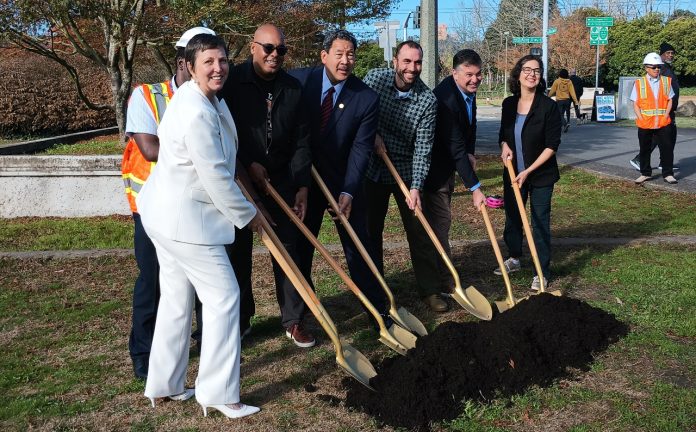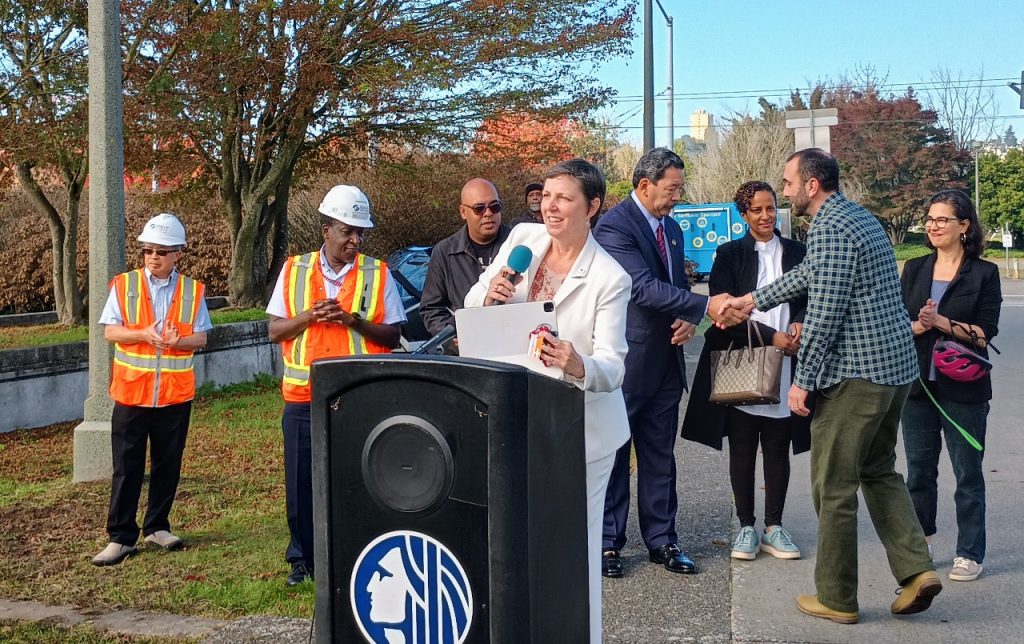
Sound Transit CEO Julie Timm will leave her post on January 12 in an abrupt departure that comes just 16 months after she took over as head of the agency in September 2022. The search for a new long-term CEO will now be added to the other significant challenges that Sound Transit faces, including cost overruns, delays in selecting station locations for future light rail expansions, and looming capacity and crowding issues as the system expands.
“The board and staff leadership will form a transition team to navigate the agency through the leadership transition. The board is expected to appoint an interim CEO in the weeks ahead,” Sound Transit spokesperson John Gallagher said in a statement.
Timm announced her departure in an email sent to Sound Transit staff Tuesday afternoon, citing personal matters that were prompting her decision.
“Over the past week in collaboration with Board Leadership, I came to the difficult, but I believe the correct, conclusion that my family needs more of my focus,” Timm wrote. “While not impossible, it would be incredibly challenging for me to maintain a split focus while maintaining the intense level of support and stability Sound Transit deserves from its CEO as we enter into a historic level of openings and new construction.”
The Sound Transit board was expected to take an official vote on the CEO’s performance this week, with frustrations mounting at the agency’s Technical Advisory Group (TAG) over a lack of movement on recommendations that would improve project management and a number of policy discussions lately that have hinted at the issues the agency will continue to run into as it tries to expand a light rail system currently serving mostly shorter trips within Seattle into a larger regional system.

Joining Sound Transit after heading up Greater Richmond Transit Company (GRTC) in Virginia, Timm brought a renewed focus on passenger experience, pushing small but impactful changes like improvements to how the agency cleans trains at either end of the Link 1 Line. But broader rider experience improvement programs, like the long-delayed and often-buggy Passenger Information Management System displaying real-time information in train stations, have remained a frustration for riders.
During her tenure, Timm stressed making intentional choices about the build out of the system that take into account the decades of future use. “If we’re building something fast, but we’re not considering how the system is being used, then we’re building something that will be defective for generations,” she told the agency’s accessibility committee.
But as CEO she has served at the pleasure of the Sound Transit board, where many representatives of suburban cities have been waiting for rapid transit investments to come to them for over two decades. With their disparate (and sometimes parochial) interests, it is no easy matter to keep this entire group happy. For example, some boardmembers are focused on stricter fare enforcement and want to add fare gates, while others stress social equity and want to avoid changes that will exacerbate racial disparities in fare enforcement and transit access.
The 18 members of the board includes the three county executives from King, Pierce and Snohomish counties, state transportation secretary Roger Millar, plus 14 members pulled from the ranks of county councils and elected city government and appointed by the respective county executive. The number of spots each county executive gets to appoint is weighted by population falling under the Sound Transit taxing authority. The result is 10 members from King County, four from Pierce, and three from Snohomish — plus Millar.
Decisions like whether to invest more dollars making transit that functions better in the heart of the system, as in the discussion over a future Chinatown-International District or South Lake Union station as part of Ballard Link extension, have not necessarily centered the needs of riders. A board that focuses on things like parking garages even as transportation industry best practices shift away from park-and-rides also illustrates a major issue that the CEO must navigate.
The Sound Transit board itself will be undergoing significant change next year already, with four members exiting at once and new members, including what is likely to be a different member of the Seattle City Council and of the King County Council joining the current board with their own agendas and priorities.

The search will begin in early 2024 for a new long-term CEO, with an interim CEO stepping into the role. Some in the agency have floated TAG member and former Bay Area Regional Transit general manager Grace Crunican as a potential pick, as someone who can jump in and steer the ship during a critical time. Crunican also ran the Seattle Department of Transportation from 2002 to 2009.
While the interim CEO may not serve long, it will be a pivotal time. Sound Transit has two major light rail expansions on deck in 2024, with abbreviated service on the 2 Line between Bellevue and Redmond set to start in spring, and the extension of the 1 Line up to Lynnwood next fall.

“The Sound Transit Board and staff leadership will form a transition team to navigate the agency through the leadership transition with a focus on stability and commitment to Sound Transit’s mission of connecting more people to more places to make life better and create equitable opportunities for all,” Sound Transit spokesperson Abel Pacheco said Tuesday.
How much of that search will be daylighted to the public is uncertain. The CEO search that brought Timm to Seattle was shrouded in secrecy, with the agency’s search committee keeping their top picks for the job close to the vest and not releasing the names of the runner-up candidates.
What is clear is that the next person to fill Timm’s shoes will have their work cut out for them, having to balance rider experience, project delivery, and board management in a way that moves an enormous agency like Sound Transit forward.
Ryan Packer has been writing for The Urbanist since 2015, and currently reports full-time as Contributing Editor. Their beats are transportation, land use, public space, traffic safety, and obscure community meetings. Packer has also reported for other regional outlets including BikePortland, Seattle Met, and PubliCola. They live in the Capitol Hill neighborhood of Seattle.

